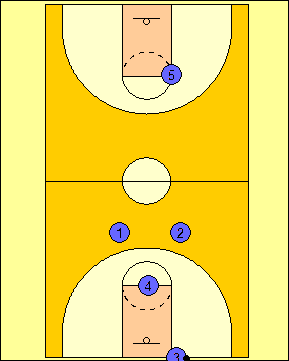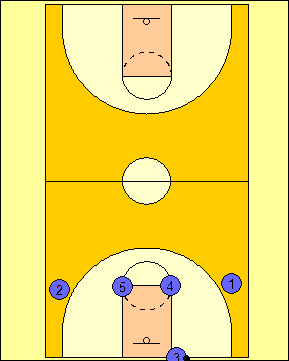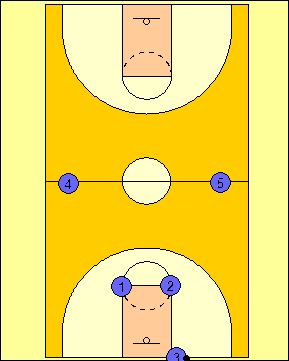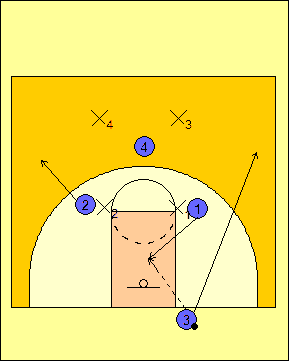|
PRESS OFFENSE
During the course of a season, teams will be put into
situations where they will have to face a pressing defense. This
could come about as an all-game strategy or as part of a strategy to
come from behind late in the game. The question is whether or not
you will be ready to face the defensive onslaught that could be coming
your way with your press offense.
The Need for Press Offense
As mentioned earlier, the two ways in which a press can be set up is as an
all-game strategy or as a way to come from behind late in the game. To
protect the basketball and to score against the defense, an effective press
offense is something that coaches will need to introduce during the preseason
and work on during the course of the year. Coaches who do not work on this
counter to the defense's strategy will invariably lose games that they should
win with the proper preparation.
General Philosophy Against the Press
Many teams struggle against pressing defenses because of
the way in which they are being attacked. With all the manpower of
the defense in your backcourt, there should be opportunities to take
advantage of the lack of players in the other team's backcourt.
When playing against the press, this should be standard operating
procedure.
The first way to take advantage of the press in this
manner is to post up a player against the press. If you are
playing a 1-2-1-1, 2-2-1, or man-to-man press, the defense will have to
take into consideration this player. Somebody on the defense has
to be responsible for him so as to not get beat deep. This forces
a four-on-four situation which favors the offense.
The other aspect is that you must make the press pay for pressing by getting as
many lay-ups as you can. If you are getting high-percentage shots against
the press, they will either have to make up for it with a high volume of scoring
or abandon the press altogether.
Some pressing teams do a great job of getting back on defense while other teams
press so softly that they naturally drop into a half-court defense of some kind.
Should this ever occur, the best course of action is to set up your half-court
offense. It is also a matter of importance that the ball be advanced past
the half-court line as quickly as possible so as to avoid the ten-second count.
Getting the Ball Inbounds
In some instances, you can get the ball inbounds before the press gets set.
If you can do this, have your nearest big man take the ball out of bounds and
get it inbounds as as soon as possible. If this is the way that you plan
to get the ball inbounds against pressure, you must not waste a second in making
this happen successfully.
Most teams like to have the nearest big man take the ball out of bounds because
it can set up the fast break offense. However, in a pressing situation, it
is best to have your best inbounds passer take the ball out of bounds in a
pressing situation. This is because he is used to making the inbounds pass
against pressure with sideline out of bounds or baseline out of bounds pass
entries.
Some of the more popular press alignments are presented
in Diagrams 1-3. Diagram 1 shows the three-up/one-back alignment,
Diagram 2 shows the four-up alignment, and Diagram 3 shows the
two-up/two-back alignment. These alignments should be used as
formations to run plays designed to get the basketball inbounds before
the five second count on the inbounds. In all of the
illustrations, the best inbounds passer is #3 and he looks to throw the
basketball inbounds.

Diagram
1 |

Diagram
2 |

Diagram
3 |
Press Offense Against a 2-2-1 Press
When facing a 2-2-1 Press, we want to get our best
ball-handler the basketball on the inbounds as shown in Diagram 4.
When this happens, we want the inbounds passer to get to an open
spot up the floor.

Diagram
4 |
Once the ball is in the hands of our best
ball-handler, we want to employ a rule for all instances when the
ball is in any given spot. We want at least three receivers
near the ball at all times. This will be true for our press
offense if we face either a 1-2-1-1 or a 2-2-1 press defense.
In Diagram 5, we show the press offense against a
2-2-1 press. Three receivers are near the ball and our
ball-handler has the option to pass to either one of the three
players. Our first option is to pass to a side while the
second option is to pass the ball to the middle. In either
instance we want to get the ball up the floor quickly so that we can
attack the basket and get high percentage shots against the press.

Diagram
5 |
If we pass the ball up the side, we have three
options available to us as shown in Diagram 6. We can pass up
the floor to #4 who gets to a spot up the sideline. We could
also hit #2 flashing to the middle or pass the ball back to #1 and
look to reverse the floor.

Diagram
6 |
The second choice is to pass the ball to the middle
of the floor and attack the basket (Diagram 7). If we get this
pass, we want to attack up the floor fast against a four-on-three
since our post-up and the defense's back defender are up the floor.

Diagram
7 |
Press Offense Against a 1-2-1-1 Press
Against the 1-2-1-1 Press, we want to get the
basketball inbounds and make quick decisions because of the
potential for traps. In Diagram 8, #1 steps into a spot where
he can receive the inbounds pass from #3.

Diagram
8 |
When the trap is set by the 1-2-1-1 press, we want
to get the ball to one of three outlets as shown in Diagram 9.
We can go up the floor to #4, split the trap and pass to #2 or look
to start a reversal with a pass back to #3 who inbounded the
basketball.

Diagram
9 |
If we are able to get the ball up the floor, we want
to break right away and get up the floor fast (Diagram 10). #2
will streak down the middle of the floor while #3 takes the opposite
lane. #1 will fill the middle spot to either receive the ball
from #4 if the advance is not successful or trails #2 up the floor.

Diagram
10 |
If we pass the ball to #2 and split the trap as we
do in Diagram 11. #3 will run up the side opposite #4 who is
also running down the floor along the sideline. Again, we want
to get a numbers advantage and score quickly to make the press pay
for pressing us.

Diagram
11 |
When we pass the basketball back to the inbounds
passer as shown in Diagram 12, we want to reverse the basketball as
quickly as possible. Diagram 13 shows the options we give to
the inbounds passer after he receives the pass back after stepping
inbounds. He can pass to the middle of the floor or he can
reverse the basketball.

Diagram
12 |

Diagram
13 |
If we elect to reverse the basketball, we will look
to advance the basketball up the floor. In Diagram 14, #2
receives the pass from #3. #4 moves to a spot up the sideline
while #1 fills the middle. From here, we are looking to get
the basketball up the floor fast and attack at will.

Diagram
14 |
If at anytime we are able to pass the ball back to
the inbounds passer and to the middle of the floor, we will attack
up the floor immediately taking advantage of the situation with a
four-on-two advantage (Diagram 15). This is not a favorite
pass of mine as it usually results in turnovers with X1 stepping in
front of the passing lane for an easy lay-up. If it does work,
it can result in a devastatingly easy basket for the offense on the
other end.

Diagram
15 |
Press Offense versus Man-to-Man
Against a man-to-man press, I like clear out as much as
possible, but to designate a player as someone who can help out if the
defense decides to trap out of the man-to-man press. As much as
possible, you do not want to turn the basketball over in the backcourt.
You must use this as an opportunity to get the ball across the
half-court line and to set up you offense.
Teaching Press Offense
When teaching press offense, it is best to present it as
a five-on-zero offense before adding defenders. This way, you can
teach concepts and plays to get the basketball inbounds. You will
also need to work with your players on how to play in broken situations.
Once your players have mastered how to run zone offense,
you can run it against token zone defenses. In some cases, this
part benefits your defense more than your offense because you can
experiment and see which press defenses you want to use during the
course of the season.
Finally, when preparing to play a pressing team, you can
work on your press offense against a defense with more defenders than
the offense has players. Start five-on-eight before going to
five-on-seven and five-on-six. Make your players have success
against the defenses before removing a defender. If your players
can score when outnumbered by the defense, you shouldn't have anything
to worry about when the game comes.
RETURN TO MEMBERSHIP AREA
© 2010-2017 Alan Peel Enterprises
|